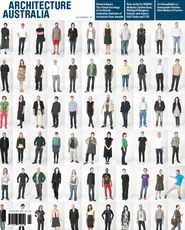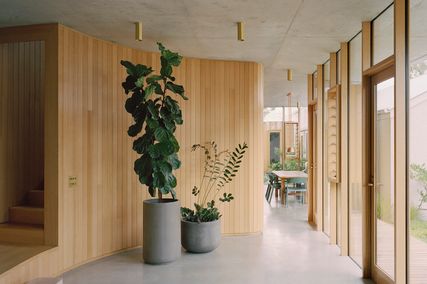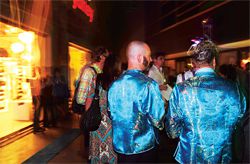
The Food for Thought team at Pecha Kucha in Syndey as part of the extra/ordinary conference.
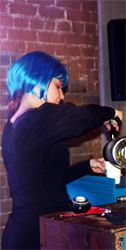
Serving soup in exchange for ideas.
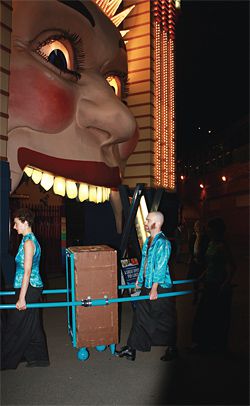
The Food for Thought team arrives at Luna Park with its “box of tricks” for the opening of extra/ordinary.

On site at the opening party.
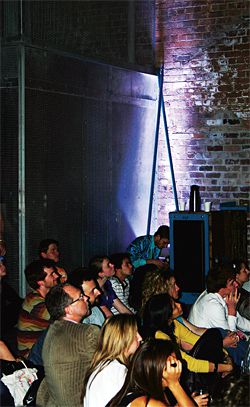
Pecha Kucha.
Performance as criticism. Linda Bennett becomes a guest soup server at Food for Thought.
On 23 April I dressed from shoulder to toe in black, not as an architect but as a ninja, to serve bowls of warm watercress soup to the audience of Pecha Kucha. I was participating in Food for Thought, and this was one of two occasions when the project inhabited the informal events associated with extra/ordinary, the national conference of the Australian Institute of Architects – the other was the opening party at Luna Park the night before.
Instigated by Thomas Rivard and Michael Lewarne, with Dario Vacirca and Andrea de Wattignar, Food for Thought is a spatial and performative experiment. The premise is uncomplicated – interested individuals submit an idea in response to a particular question; in return they receive a bowl of soup – but the concept represents a significant departure from current and conventional architectural modes of discussion and production.
I was interested to take part in Food for Thought because it pursues architectural critique through participation and performance rather than writing, drawing or theorizing. It is a grassroots, guerilla-style spatial assault that brings together diverse ideas and opinion.
At extra/ordinary, Food for Thought sought to use the combined talents of 1,000 architects to develop ideas and to create unsolicited community-based projects, in the belief that 1,000 minds in the conference audience might work together to produce something more thoughtful and relevant.
In line with the theme of the conference, participants were asked for ideas on how a sacrosanct site might be Ooccupied. At Pecha Kucha alone we received over 200 ideas – they were fictional, practical, demanding and generous. For the most part, the proposals were driven by political or social goals. Typically, participants’ ideas reconceptualized traditional values and opted against conventional means of practice. On the topic of new projects for Sydney, Keith Drew from Hobart suggested that the Luna Park ferris wheel be transformed into temporal sleeping capsules for the homeless. Michael McMillan from Geelong suggested we dam Sydney Harbour to create high-density residential refugee camps. Responding to ideas of community, Daniel Beasly from Sydney suggested weekly neighbourhood raids to ensure people really are using less. David Neustein from Sydney suggested we bury fifty dollar notes in soil. Their ideas, along with many others, were full of curiosity and energetic descriptions of change but, most importantly, the responses were productive and genuine, addressing unexpected and immediate questions. Collectively their ideas were broader and less traditional than those described by the speakers at the conference. Most refreshing were the proposals of revolt and nonconformity. David Neustein also suggested we unite to physically scar the perfect ground planes of Sydney with our Stanley knives.
In future Food for Thought events, the answers of the participants will be disseminated to the public through a scrolling LED display at the subsequent installation and via the Food for Thought website, Twitter and Facebook pages. A report will also be prepared and distributed to the public and industry. The Food for Thought suggestions form an ongoing dialogue with the city, and it may be that they are used to inform proposed and public interventions and projects.
Food for Thought provides a departure from the standardized format of industry events such as conferences. Too often, themes are set by a single group of organizers, with a focus on the selected speakers. The audience’s desire to expand, to question and to learn – the very reason that I hope they have attended – is to be satisfied by the isolated accomplishments of the architectural protagonist. But is this enough? I would argue that this format reflects a profession that is increasingly introverted and unchallenging. Theme and speaker selection of extra/ordinary sought to present tangential, radical modes of architectural practice; however, the accepted format of a limited number of “star” speakers still encouraged a passive audience.
A conference is also an opportunity for practitioners to come together and talk informally, in between speakers or over a few drinks at the bar. I believe this is where the real, bottom-up, collective design agenda can be determined. Food for Thought, along with the conference foyer “actions”, sought to use these informal contexts to make new connections with and among the audience, thereby encouraging the discussion of alternative ideas. The location, format and participatory nature of the Food for Thought project presents a direct and active critique of the traditional manner in which most architectural discussions and projects are conducted.
The conference was the second installation of Food for Thought, which began in April at Broken Hill. The project will have an ongoing life and there are plans to temporarily locate Food for Thought activities in a range of urban spaces. The next installation will be at the Bondi FM Cafe on 13 June, followed by the 2010 Sydney Design Festival and the 2010 Venice Architecture Biennale. There are ongoing discussions with the City of Sydney, Auburn Council and Bankstown Council. To quote Rivard and Lewarne, “A multifaceted progeny of organ-grinder, ice cream cart, puppet theatre and TARDIS, Food for Thought is an active presence, attracting locals and passersby with the prospect of free soup.” Rivard and Lewarne seek to engage a broader public, expanding participation beyond the architectural community. However, for an even greater cross-section of opinion, I’d like to see Food for Thought at Martin Place or at Summernats.
The ambition to “stimulate discussion about the future of urban and civic spaces” among a wider public is particularly important. If architecture is to participate in future urban challenges, we need to find new means of engaging and to explore how architecture might evolve in the face of these challenges. I believe we must start by fostering a dialogue that identifies the architect not as the singular visionary, but as the collective diplomat, a professional who seeks opportunity and focuses on re-establishing authentic relations. To do this, we need to develop alternative ways to produce projects and to actively reconceptualize architectural criticism.
I would argue that contemporary architectural criticism has become increasingly distanced from productive means of action. Yet, if we hope to have an effect as a profession we need to engage with a public audience in a way that is appealing, dynamic and tangible. Food for Thought provides a useful means of doing this. Through performance and participation it questions a heroic, insulated and isolated architectural practice through urban action. Its critique is harvested from the physical and intellectual exchange of anonymous and collective ideas across urban space.
Architectural practice and criticism need to respond more directly to the common space that surrounds us, and not merely engage with the 5 percent of the built environment that architects are currently involved in. The format of Food for Thought is not the answer but rather a critique that reconceptualizes architectural practice and criticism. Could we be more active and productive if projects were established and discussed by both the public and the collective profession? Would we be more purposeful if architectural criticism was more confronting and less traditional?
Linda Bennett blogs at Archi-Ninja.com and is an architecture student at University of Technology, Sydney.

